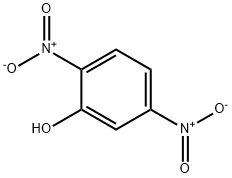2,5-디니트로페놀 C화학적 특성, 용도, 생산
화학적 성질
Yellow needles, flammable. Soluble in ether, benzene, hot water, and ethanol.
일반 설명
Yellow crystalline solid with a sweet musty odor. Sinks and mixes slowly with water.
공기와 물의 반응
Slowly mixes with water.
반응 프로필
2,5-DINITROPHENOL can detonate or explode when heated under confinement [USCG, 1999]. Phenols do not behave as organic alcohols, as one might guess from the presence of a hydroxyl (-OH) group in their structure. Instead, they react as weak organic acids. Phenols and cresols are much weaker as acids than common carboxylic acids (phenol has Ka = 1.3 x 10^[-10]). These materials are incompatible with strong reducing substances such as hydrides, nitrides, alkali metals, and sulfides. Flammable gas (H2) is often generated, and the heat of the reaction may ignite the gas. Heat is also generated by the acid-base reaction between phenols and bases.
건강위험
INHALATION, INGESTION OR SKIN ABSORPTION: Fatigue, thirst, sweating, flushing of face, nausea, vomiting, abdominal pain, diarrhea; restlessness, anxiety, excitement occasionaly leading to convulsions; fever, tachycardia, labored respiration, cyanosis, and sometimes muscle cramps. Loss of consciousness, cessation of breathing and death. EYES: Causes dilation of pupils or posterior subcapsular opacities or cataracts. SKIN: Discoloration, irritation, and dermatitis.
Purification Methods
Crystallise 2,5-dinitrophenol from H2O with a little EtOH. [Beilstein 6 IV 1383.]
2,5-디니트로페놀 준비 용품 및 원자재
원자재
준비 용품










